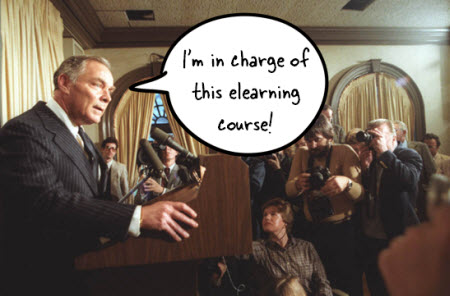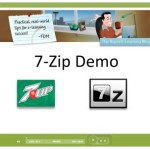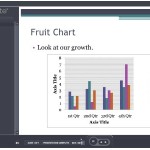Another good post. I do something similar with the folders. For images and files we always use the date and version. Example: FILENAME_110927v1
3 Ways to Avoid Common Roadblocks When Building E-Learning Courses
September 27th, 2011
Building elearning courses is hard enough. Most people are working with limited resources and time. So having to deal with anything that slows down the process is a hassle. Here are three common roadblocks and ways to avoid them.
Lack of Clear Objectives
I get to look at hundreds of courses during the year. One of the biggest issues I see is that the objectives of the course aren’t clear. They’re all wishy-washy with statements like you’ll “learn” or “understand.” They tell you what you should learn, but they should be telling you what you’ll be able to do.

Don’t make a list of objectives based on what a person should learn or understand. Instead declare what the person will be able to do. And then determine how you’ll prove that they can do it.
At a previous place we used to ask, “If I saw it in action, what would it look like?” This helped us to focus on actionable results. If there’s nothing to see or no real action associated to the course completion, then you might want to consider not building the course.
Sloppy Asset Management
One of my pet peeves is tangle cords. There’s nothing more frustrating than going to get an extension cord or a power adapter out of a box and find it all tangled and knotted.
In the elearning world, sloppy asset management is like a box of tangled cords. It wastes time because it’s hard to find what you need when you need it. This is easy to avoid.

Here are two simple things you can do:
- Create a generic folder structure for your courses. I have a folder that I copy when I start a new project. Inside that folder are other folders that will hold the courses assets. Some of the sub folders I have are: Quizmaker, Engage, Flags, audio, images, notes, fonts, templates, etc. Every course I build uses the same folder structure so I know where things are and it’s easy to share the project folders with others.
- Come up with a consistent naming structure. I’ll have to admit that I can get a little sloppy on this myself. I don’t know how many “temp” folders I have on my desktop. There’s no set rule on how to do it, but come up with a consistent way that you and your team can identify and label your files. Common elements are version numbers and date created.
Who Controls the Content?
Who owns the content and has final say on the design and implementation of the elearning courses? If you’re the subject matter expert and final authority of the content, then that’s perfect. But for many, that’s not the case. Find out who owns the content.

There are a few things to consider:
- Who can help you identify and craft actionable objectives?
- Who gets to offer feedback and make changes to the content?
- Who owns the final sign off? Pull those people in right away so you don’t have to make last minute changes.
There’s a lot that goes into building elearning courses; and with that a lot that can slow things down. Develop clear objects, keep track of your files, and make sure you’re connected to the right people. That’ll help you stay on top of things and make the development process much more successful.
What are some roadblocks you experience? What do you do to avoid them? Feel free to add your thoughts via the comments link.
Events
- Everyday. Check out the weekly training webinars to learn more about Rise, Storyline, and instructional design.
Free E-Learning Resources
 |
 |
 |
|
Want to learn more? Check out these articles and free resources in the community. |
Here’s a great job board for e-learning, instructional design, and training jobs |
Participate in the weekly e-learning challenges to sharpen your skills |
 |
 |
 |
|
Get your free PowerPoint templates and free graphics & stock images. |
Lots of cool e-learning examples to check out and find inspiration. |
Getting Started? This e-learning 101 series and the free e-books will help. |
31 responses to “3 Ways to Avoid Common Roadblocks When Building E-Learning Courses”
Hey Tom!
These points are to true! Do you have any tips for setting boundries for SMEs? For example, when you have a SME who thinks it’s his/her job to develop the course? I’ve often run into this problem at my work. It is compounded by the fact that the SMEs are much higher than me on the org chart.
…I have enough trouble doing it with my 5-year old.
[…] View post: 3 Ways to Avoid Common Roadblocks When Building E-Learning Courses #ELearning […]
Great ideas Tom. When you create your “folder template” would you also pre-populate the underlying folders with content that you would regularly use or require when you are working on your projects?
Love the “Atom Heart Mother” tribute pic, and on the same day the remastered version comes out even!
Great post, and I agree wholeheartedly with your point #1…it should be about behavior change or a new skill, not a set of rote learning objectives.
Very interesting article! The objectives section really resonated with me, especially the concept of ‘what you will learn’ vs ‘what you can do.’ I’ve fallen into the trap of only giving vague learning objectives instead of action-oriented ones, and I think it does add something to outline it more clearly. I will definitely keep this in mind in the future.
Great post!
Thanks, Tom! I made an index card that says, “If I saw it in action, what would it look like?” and posted it on my PC as a reminder to ask that great question. 🙂
My biggest roadblocks are my SMEs. Since I’m creating e-learning for the legal field, it is vital that a judge/lawyer verifies the legal correctness of my work. I find the SMEs to be very slow to respond to my requests that they verify what I have created. How does one get buy-in and quicker responses from very busy people? I mean, they say they’ll help at the beginning of the project, but their help doesn’t come in a timely manner.
Very good post!
I’m finding that the folders help me stay organized as well and keeping a good version control system of your course after reviews. Oftentimes, SMEs will change their mind in terms of what they want in the course.
Road blocks I’ve experienced? Well, that would be the level of interactivity i’m adding in the course. It helps to have Reusable Objects so you don’t spend a great deal of time trying to design interactivity that requires testing and hard core development.
Tom,
While I agree that objectives should be based on actionable results, not all training is meant to result in the ability to do something. In our organization we have several courses whose purpose is to impart specific knowledge, so the objective is that they will know something they did not previously know. True, this often is part of a process that leads to the ability to do something, but the course itself does not accomplish this. An example would be knowledge that they need in order to successfully participate in an OJT event that results in their ability to perform the task.
The biggest roadblock I see is stakeholders not being able to express what they want taught in a course.
In follow-up to my previous post. I could not agree more aboouty your tangled cord analogy. I, too, hate tangled cords! Unfortunately, I am more than guilty when it comes ot organizing files. I have done exactly what you recommend, creating a folder structure that I use for all my courses. It does, indeed, make it easy to mfind what I need.
Keeping control of content is essential. Too many cooks do indeed spoil the broth. Having final content approval specifically (sp?) designated is essential.
Great post, thanks!
Try to think like your students.
I can’t tell you how many times I hear faculty say, “Why can’t these students follow simple instructions?”
If necessary, hire a student(s) to review your content and instructions. See if they are able to describe what you’re intending based upon your “simple” instructions.
Listen to them and you may be surprised.
Thanks for a post that is relevant to where my team is at in our current project – planning and outlines. You are making me rethink some design templates and workflows.
Love the Alexander Haig reference!
Good post – and I laughed out loud (really) when I saw the illustration (of Alexander Haig at the podium) for your third point. Made your point AND referenced an interesting episode in U.S. history!
Thanks for your tips. I learn a lot with your posts.
@Ed: this applies as much to knowledge as it does to skill. The real question is how will you know that they ‘know something they did not previously know’ as a result of your training?
Classically, action statements for knowledge learning incorporate words such as:
– Explain
– Identify
– List
– Discuss
– Debate
– Articulate
– Participate
– Answer
It’s always about what evidence you could collect to prove that your training resulted in learning. For example, let’s say that you are delivering training on Superannuation (compulsory retirement savings scheme in Australia).
Your action objectives could be as follows:
1 Explain the purpose of superannuation
2 Identify when you can access your super
3 Discuss the primary reasons that superannuation is compulsory
4 List the legislation that relates to Superannuation
5 Debate the merits of superannuation
6 Answer key questions regarding superannuation
Tom, as usual, you just manage to pick topics which are so very relevant to us! The biggest roadblock I have faced while designing courses are actually two:
1. the stakeholders are not sure who is the final authority in signing off the content – after insisting throughout the project they are the final authority when we request for the final sign off for publishing the course,suddenly another stakeholder is identified and then the whole process starts all over again!
2. Creating the right objectives – so many times,the SMEs will simply want to change the objective because they do not “feel” that its the right one! Then you spend so much time trying to explain to them why the stated objective is exactly what the learner is expected to do after the course!
Regarding the folder structure, I keep it very simple – three folders: Development, Publish, SME Documents. the development folder has two sub-folders: Storyboard and Images. The Publish files stored in their respetives phases (Alpha, Beta or Gold)and of course all content received from SME in the SME Document folder.
Request Tom, if we could have a lengthier write up on the first point highlighted in this post: Lack of Clear Objectives.
Thanks,
Chaitali
This is a great topic and I just encountered some of these points mentioned. As I am typing this message I am trying to find the pieces in a puzzle of documents that need to be relinked to a powerpoint. They hired an external company, that was not really good at making elearnings and forgot to make good arrangements in the contract in types of quality. So the learning goals have been missed and now I am trying to make something out of the soup of files to update this sloppy course.
On another note, I would love to see some more thoughts on the learning objectives. How specific are you in them and how do you manage to put it into the course and (over time) stick with the design. Thanks for the post!
For Learning objectives, we normally use Bloom’s taxonomy which provides measurable and observable verbs on learning.
Tom, I am a relatively new reader of your blog. But, I suspect I’ll be a long time reader because I appreciate your point of view.
ON OBJECTIVES
I’ve been in the business for four decades: first as a teacher; then as a trainer, technical writer, and training developer (using multiple media); then as a performance technologist, which I’ve been for the last twenty years. For about half of that time, I had problems with most approaches to stating objectives.
Bloom’s taxonomy was helpful when I was an educator. But, I struggled with determining the best verb from the taxonomy for my objective. Most teachers simply select those verbs that would be be the easiest to teach and test.
Mager’s behavioral objectives were an improvement. But, they quickly became a cliche, something that students skipped over to get to the “important” stuff. Worse, I saw a lot of trainers misusing their behavioral objectives.
For example, “At the end of this module, given a written test, the trainee will be able to answer 80% of the questions correctly.” How is that useful for the developer, the trainer, or the trainee? It isn’t.
Everyone seemed to be jumping through hoops simply to fulfill the requirement for objectives, but the objectives we produced varied widely in there usefulness.
If the purpose of training is to produce competent employees ready to perform their job to exemplary standards, then why don’t our objectives deal directly with the job?
And, since our clients (internal or external) value results more than knowledge or behavior, why don’t we specify our objectives in terms of what the trainee will produce/accomplish (things of value to the organization)?
Here is an example of a hierarchy of objectives (accomplishments) that I think are more useful.
• A safe nation (a “corporate” accomplishment — Homeland Security)
• Safe shores and harbors (a “division’ accomplishment — the US Coast
Guard)
• Victim in basket ready to be hoisted to helicopter (a job accomplishment –
Rescue Swimmer)
• Swimming gear ready for emergency (a major accomplishment – Rescue
Swimmer duty)
• Wet suit ready for donning (a task accomplishment)
• An unzipped back zipper (a step accomplishment)
Notice that the last four accomplishments can easily be restated as objectives:
• At the end of this curriculum, you will be able to rescue a person in the water to these standards:…
• At the end of this course, you will be able to prepare all of your swimming gear so that it is ready to be used in an emergency
• At the end of this module, you’ll be able to store your wet suit so it will be ready for rapid donning in emergencies (see the standards listed below)…
Trainees will be more likely to be motivated to take the curriculum, each course, and each module because each objective is clearly related to the trainee’s job–the value is apparent to the trainee.
The client is more likely to provide needed resources for a curriculum described this way because they can see the value.
Curriculum designers are less likely to include nice-to-know but unnecessary information, making the course more effective and efficient.
Trainers know exactly what they have to teach and what has to be demonstrated, tried out, and practiced.
[…] 3 Ways to Avoid Common Roadblocks When Building E-Learning Courses […]
All great tips…when I was taking Adobe Flash courses – one of the first lessons was asset management, which has helped me immensely throughout my projects. Clear objectives take some research, SME interviews, and old-fashioned brainstorming (usually on my own).
Question for all of you:
What is your strategy to get the most information from a SME? Specifically, when they are not sure what they want – they just know they need some type of training for “it”?
You made some fine points there. I did a search on the matter and found a good number of folks will consent with your blog.
[…] 3 Ways to Avoid Common Roadblocks When Building E-Learning Courses » The Rapid eLearning Blog Building elearning courses is hard enough. Most people are working with limited resources and time. […]
[…] 3 Ways to Avoid Common Roadblocks When Building E-Learning Courses […]
[…] on http://www.articulate.com Share this:TwitterFacebookMorePinterestTumblrStumbleUponRedditDiggLinkedInPrintEmailLike […]
[…] 3 Ways to Avoid Common Roadblocks When Building E-Learning Courses […]
As usual the blogs are always informative. This is however is request a for feature, can the option to download the blog as a PDF be made available?
I am assuming that this blog is powered by WordPress, if so incorporating a PDF plugin is quite painless.
Thanks again…









0
comments